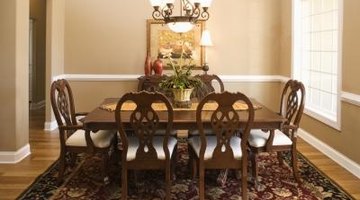Pros & Cons of Counter-Height Tables
A counter-height table is taller than the average dining room table. Though traditional, regular-height tables are more common, counter-height tables are especially useful in small dining rooms and modern furniture settings. As with any type of furniture piece, a counter-height table has pros and cons that you should consider before purchasing.
Pro: Space

Counter-height tables typically range from 35 to 36 inches tall. While you can use counter stools for seating, most tables come with a set of chairs premeasured and formed for the tables' heights. Counter-height tables allow for extra leg room, which is especially comfortable for those people who are too tall to sit comfortably at a regular-height table. Though counter-height tables are usually as large as typical tables, they give an illusion of saving space. Some counter-height models actually are space savers because they have insert leaves, which allow the tables to fold up into smaller units or expand to accommodate more guests.
Pro: Highchairs
With regular-height tables, children sitting in highchairs tower over other people who are sitting at the table. With a counter-height table, children in highchairs are at the same level as the adults and other children. This makes feeding your child easier, but also helps to involve the child in more dinner activities.
Con: Comfort
Counter-height tables accommodate tall guests, but guests who have back issues may find these tables and their chairs uncomfortable. Regular-height tables allow your feet to touch the ground, whereas a counter-height table does not. If you suffer from back issues, this type of seating may cause you strain.
Con: Safety and Children
Though a counter-height table is only 36 inches tall, it is a long drop for small children. Children can fall from chairs or loose booster seats, causing injury. Children who rock in their chairs can also become injured if a counter-height chair topples over, since it is a longer drop than an average-height chair.
Cons: Style and Design
Counter-height tables are not as common as regular-height tables at furniture stores. Therefore, you will find a limited number of styles and designs at each store that you visit. When shopping for a particular color of wood or style of table, such as French style, it may be difficult to get a counter-height table that suits your design needs.
References
Writer Bio
Shailynn Krow began writing professionally in 2002. She has contributed articles on food, weddings, travel, human resources/management and parenting to numerous online and offline publications. Krow holds a Bachelor of Science in psychology from the University of California, Los Angeles and an Associate of Science in pastry arts from the International Culinary Institute of America.
Photo Credits
- Jupiterimages/Comstock/Getty Images
More Articles



